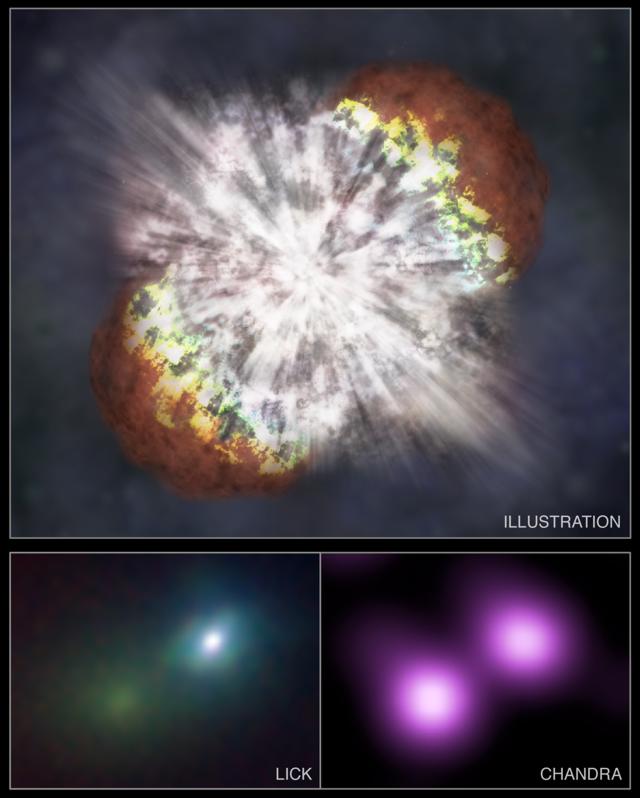Hellste Supernovaexplosion
Sternenexplosion sprengt alles bisher gemessene Maß
Harrisburg (dpa) - Eine gewaltige Sternenexplosion in tiefster Ferne des Alls fasziniert die Astronomen: Ein NASA-Satellit hat am 19. März die hellste Explosion registriert, die jemals beobachtet wurde. Sie war 2,5 Millionen Mal heller als die leuchtstärkste bisher beobachtete Supernova, wie die US-amerikanische Pennsylvania State University am Donnerstag (Ortszeit) berichtete. Der Gammastrahlen- Ausbruch war so hell, dass sein Licht sogar mit bloßem Auge zu sehen gewesen sei. Gammastrahlen-Ausbrüche sind nach dem Urknall
Anmerkung (KPH): Der Urknall war keine Explosion.....
die stärksten Explosionen im Universum.
Das am 19. März um 02.12 Uhr erfasste Licht des Sternengeschehens musste das halbe Universum durchqueren und damit 7,5 Milliarden Lichtjahre bis zur Erde zurücklegen. Damit ist das Phänomen das fernste bekannte Objekt, das von Menschen ohne Hilfsmittel am Nachthimmel wahrzunehmen war. Den bisherigen Rekord hielt die relativ nahe gelegene Galaxie M33, die in einer Entfernung von «nur» 2,9 Millionen Lichtjahren zur Erde mit bloßem Auge zu sehen war, wie die US-Astronomen berichteten.
Über das vom NASA-Satelliten «Swift» registrierte Licht äußerten sich die Wissenschaftler überwältigt. «Innerhalb von 24 Stunden haben wir eine unglaubliche Aktivität am Himmel beobachtet - allein 5 Gammastrahlen-Explosionen und verschiedene andere Ausbrüche. Und in der Mitte von all diesem Geschehen war das leuchtendste Strahlen, das wir je gesehen haben», sagte der Astronom und Astrophysiker Prof. David Burrows stellvertretend für die Wissenschaftler und Ingenieure an der Bodenstation von «Swift» in der Nähe der Universität. «Der Ausbruch fegt alles hinweg, was wir bisher an Gammastrahlen- Explosionen gesehen haben», sagte auch NASA-«Swift»-Experte Neil Gehrels.
«Wir haben auf so einen intensiven Gammastrahlen-Ausbruch gewartet, seitdem "Swift" vor drei Jahren mit der Beobachtung des Himmels begann», sagte Burrows weiter. «Und nun haben wir so eine Strahlenintensität bekommen, dass sie mit dem bloßen Auge zu sehen war, obwohl ihre Quelle das halbe Universum entfernt liegt.»
Sein Fachkollege Derek Fox sagte, falls sich der Ausbruch in unserer Galaxie ereignet hätte, hätte er fast eine Minute lang heller geschienen als die Sonne. Die meisten Gammastrahlen-Explosionen erfolgen, wenn massiven Sternen die Energie ausgeht. Dann kollabieren ihre Kerne zu sogenannten Schwarzen Löchern oder Neutronensternen, wobei sie explosionsartig enorme Energie freisetzen.
Prof. Peter Meszaros, einer der Leiter des «Swift»-Teams, vermutet eine ungewöhnliche Kombination der Umstände, die zu dem außergewöhnlich hellen Leuchten beigetragen haben könnten. Wenn die Strahlen aus der Explosion auf Gaswolken treffen, könnten diese «Jets» dadurch noch heißer werden, erläuterte er seine Hypothese. Die Astronomen katalogisieren die Super-Explosion unter der nüchternen Nummer GRB 080319B - das steht für den zweiten am 19. März 2008 registrierten Gamma-Ray Burst (GRB).
A Burst to See
Observing the distant Universe with the unaided eye
On 19 March, Nature was particularly generous and provided astronomers with the wealth of four gamma-ray bursts on the same day. But that was not all: one of them is the most luminous object ever observed in the Universe. Despite being located in a distant galaxy, billions of light years away, it was so bright that it could have been seen, for a brief while, with the unaided eye.
Gamma-ray bursts (GRBs) are short flashes of energetic gamma-rays lasting from less than a second to several minutes. They release a tremendous quantity of energy in this short time making them the most powerful events since the Big Bang. It is now widely accepted that the majority of the gamma-ray bursts signal the explosion of very massive, highly evolved stars that collapse into black holes.
Gamma-ray bursts, which are invisible to our eyes, are discovered by telescopes in space. After releasing their intense burst of high-energy radiation, they become detectable for a short while in the optical and in the near-infrared. This 'afterglow' fades very rapidly, making detailed analysis possible for only a few hours after the gamma-ray detection. This analysis is important in particular in order to determine the GRB's distance and, hence, intrinsic brightness.
The gamma-ray burst GRB 080319B was detected by the NASA/STFC/ASI Swift satellite. "It was so bright that it almost blinded the Swift instruments for a while," says Guido Chincarini, Italian principal investigator of the mission. A bright optical counterpart was soon identified in the Boötes Constellation (the "Bear Driver" or "Herdsman"). A host of ground-based telescopes reacted promptly to study this new object in the sky. In particular, the optical emission was detected by a few wide-field cameras on telescopes that constantly monitor a large fraction of the sky, including the TORTORA camera in symbiosis with the 0.6-m REM telescope located at La Silla, able to record the event with unprecedented temporal resolution..
"These very early detections (just seconds after the beginning of the burst) showed the object to be so bright that it would have been visible just with the unaided eye," says Stefano Covino, from the REM team. "It was astonishing to see how rapidly the source varied during the observations," adds Sergey Karpov, of the TORTORA team.
Astronomers use the so-called magnitude scale, an inverse scale where fainter objects have larger magnitudes. In dark sites, the most acute of human eyes can distinguish sources as faint as magnitude 6. GRB 080319B was slightly brighter than this limit, although for just less than a minute.
The 8.2-metre ESO Very Large Telescope also reacted to the gamma-ray burst, thanks to a special procedure known as the rapid-response mode, which allows automatic observations with no human intervention. The high-resolution spectrograph UVES could collect exquisite data starting only 10 minutes after the burst, following requests by Fabrizio Fiore and his team. Another team then used also UVES to determine the distance of the burst.
"Despite its stunning brightness, the burst exploded in a galaxy 7.5 billion light years away," says Paul Vreeswijk, who led the second team. "It was therefore not only apparently bright, but also intrinsically very luminous. Indeed, it reached the brightest optical luminosity ever recorded for any astronomical object. For comparison, should the burst have exploded in our Galaxy, it would have lit up the night sky for several minutes as if it were daytime."

